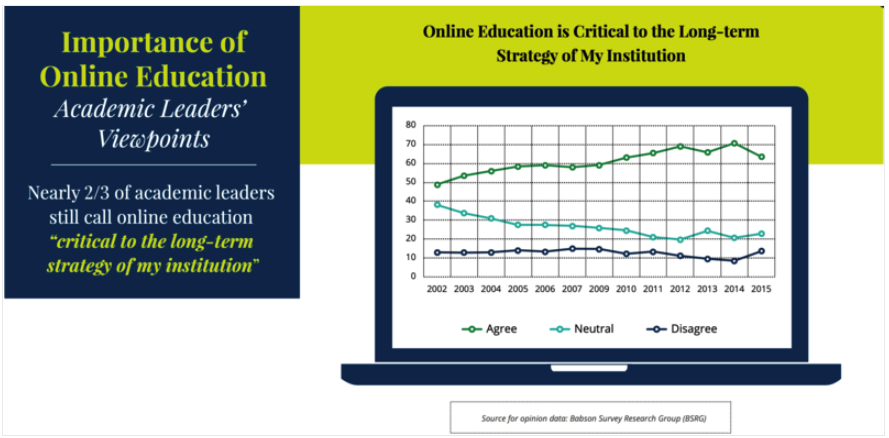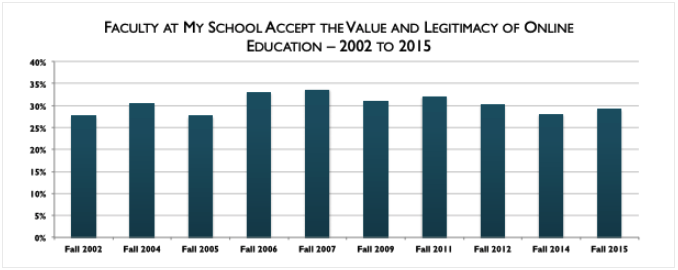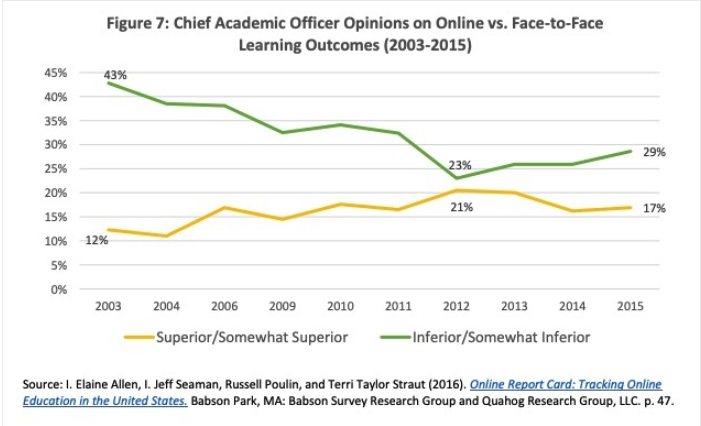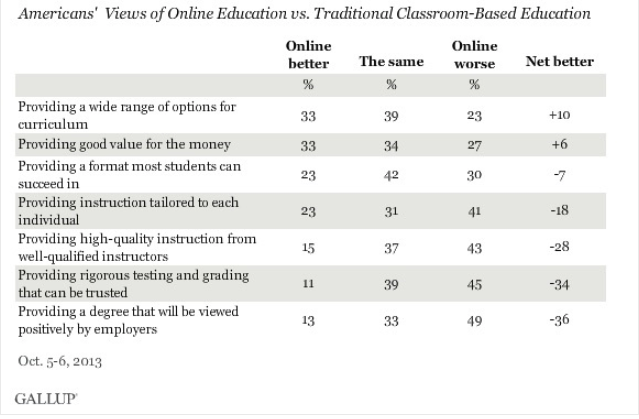Online Classes Vs. Traditional Classes Essay
Online vs. in-person classes essay – introduction, online and traditional classes differences, works cited.
The article compares and contrasts online classes and traditional classes. Among the advantages of online classes are flexibility and convenience, while in-person classes offer a more structured learning environment. The author highlights that online lessons can be more cost-effective, although they lack support provided by live interactions. Overall, the online vs. traditional classes essay is very relevant today, and the choice depends on the individual student’s needs and preferences.
Modern technology has infiltrated the education sector and as a result, many college students now prefer taking online classes, as opposed to attending the traditional regular classes. This is because online classes are convenient for such students, and more so for those who have to both work and attend classes.
As such, online learning gives them the flexibility that they needed. In addition, online learning also gives an opportunity to students and professionals who would not have otherwise gone back to school to get the necessary qualifications. However, students who have enrolled for online learning do not benefit from the one-on-one interaction with their peers and teachers. The essay shall endeavor to examine the differences between online classes and the traditional classes, with a preference for the later.
Online classes mainly take place through the internet. As such, online classes lack the regular student teacher interaction that is common with traditional learning. On the other hand, learning in traditional classes involves direct interaction between the student and the instructors (Donovan, Mader and Shinsky 286).
This is beneficial to both the leaner and the instructors because both can be bale to establish a bond. In addition, student attending the traditional classroom often have to adhere to strict guidelines that have been established by the learning institution. As such, students have to adhere to the established time schedules. On the other hand, students attending online classes can learn at their own time and pace.
One advantage of the traditional classes over online classes is that students who are not disciplined enough may not be able to sail through successfully because there is nobody to push them around. With traditional classes however, there are rules to put them in check. As such, students attending traditional classes are more likely to be committed to their education (Donovan et al 286).
Another advantage of the traditional classes is all the doubts that students might be having regarding a given course content can be cleared by the instructor on the spot, unlike online learning whereby such explanations might not be as coherent as the student would have wished.
With the traditional classes, students are rarely provided with the course materials by their instructors, and they are therefore expected to take their own notes. This is important because they are likely to preserve such note and use them later on in their studies. In contrast, online students are provided with course materials in the form of video or audio texts (Sorenson and Johnson 116).
They can also download such course materials online. Such learning materials can be deleted or lost easily compared with handwritten class notes, and this is a risk. Although the basic requirements for a student attending online classes are comparatively les in comparison to students attending traditional classes, nonetheless, it is important to note that online students are also expected to be internet savvy because all learning takes place online.
This would be a disadvantage for the regular student; only that internet savvy is not a requirement. Students undertaking online learning are likely to be withdrawn because they hardly interact one-on-one with their fellow online students or even their instructors. The only form of interaction is online. As such, it becomes hard for them to develop a special bond with other students and instructors. With traditional learning however, students have the freedom to interact freely and this helps to strengthen their existing bond.
Online learning is convenient and has less basic requirements compared with traditional learning. It also allows learners who would have ordinarily not gone back to school to access an education. However, online students do not benefit from a close interaction with their peers and instructors as do their regular counterparts. Also, regular students can engage their instructors more easily and relatively faster in case they want to have certain sections of the course explained, unlike online students.
Donovan, Judy, Mader, Cynthia and Shinsky, John. Constructive student feedback: Online vs. traditional course evaluations. Journal of Interactive Online Learning , 5.3(2006): 284-292.
Sorenson, Lynn, and Johnson, Trav. Online Student Ratings of Instructions . San Francisco: Jossey Bass, 2003. Print.
- Chicago (A-D)
- Chicago (N-B)
IvyPanda. (2023, October 28). Online Classes Vs. Traditional Classes Essay. https://ivypanda.com/essays/online-classes-vs-traditional-classes-essay/
"Online Classes Vs. Traditional Classes Essay." IvyPanda , 28 Oct. 2023, ivypanda.com/essays/online-classes-vs-traditional-classes-essay/.
IvyPanda . (2023) 'Online Classes Vs. Traditional Classes Essay'. 28 October.
IvyPanda . 2023. "Online Classes Vs. Traditional Classes Essay." October 28, 2023. https://ivypanda.com/essays/online-classes-vs-traditional-classes-essay/.
1. IvyPanda . "Online Classes Vs. Traditional Classes Essay." October 28, 2023. https://ivypanda.com/essays/online-classes-vs-traditional-classes-essay/.
Bibliography
IvyPanda . "Online Classes Vs. Traditional Classes Essay." October 28, 2023. https://ivypanda.com/essays/online-classes-vs-traditional-classes-essay/.
- Technology Ruins One-on-One Interaction and Relations
- Remote vs In-person Classes: Positive and Negative Aspects
- Mathematics Teaching Approaches in Burns' Study
- The Impressions of Emirati Youths on ISIS
- Managers’ Training Proposal
- Coaching Approaches. Separation by Target and Source Data.
- Walmart Workplace Aspects Analysis
- The Value of In-Person Human Interaction
- Organizational Behavior and Workplace Conflicts
- Educator Ethics: The Case Study
- Principles Application in E-Learning
- Cambourne’s Conditions of Learning
- Concept of Transformative Learning in Modern Education
- Podcasts as an Education Tool
- Wikis as an Educational Tool

Compare and Contrast Essay: Online vs. Traditional Education
Several differences between online and traditional education would be worth considering for students when choosing the learning method that would perfectly fit with their time schedules, learning style, and type of learners they are. Online as well as traditional education involves the same lesson content. Both involve knowledge and difficulty, but with different mediums, teaching methods, environments, and educational tools.
First, when it comes to full-job students or parents who seek to achieve their educational goals, online education would be their best choice since most online courses offer a flexible schedule that allows the student to complete their assignments at any time. On the contrary, traditional education is for students who would go through the classroom environment and devote the priority of their time to their education. Traditional learning is learning face to face with other students in the presence of a teacher or instructor that restricts students with a specific time and designated place.
Second, although online learning is more flexible, it requires a person’s responsibility and self-discipline. During online learning, the student is responsible for allotting the time to finish assignments, study course lessons, and have the ability to motivate themselves to complete work before deadlines. Conversely, traditional or classroom education is a vital tool on the issue of motivation and discipline since students would have to comply with the teacher’s given time to complete projects, presentations, and preparation for exams, in addition to the competitive atmosphere among students that stimulates them to work their best.
Furthermore, traditional learning is better when it comes to social interaction because teachers and students would have face-to-face interactions that help to strengthen the student’s ability to collaborate and work in groups to solve a problem, work on a project or listen to each other's viewpoint on a topic or issue of importance. In contrast to classroom learning, online students work individually on their assignments most of the time.
Finally, as there are many similarities between online and in-person education, there are some key differences to look for when deciding what learning method is appropriate for a student’s preferable timetable, learning style, and teaching methods.
Related Samples
- Research Paper about Homeschooling
- Importance of a College Degree Essay Example
- Argumentative Essay Sample: High School Students Should Have a Part Time Job
- Scholarship Application Letter Example
- Public Schools vs. Private Schools Essay Sample
- Negative Effects of Reading Essay Sample
- Education, Knowledge and Learning Essay Example
- Statement of Purpose Example: Mississippi State University M.S. Educational Psychology
- English 102 Course Analysis Essay Example
- Narrative Essay Sample: Challenges in High School
Didn't find the perfect sample?

You can order a custom paper by our expert writers
A Comparison of Student Learning Outcomes: Online Education vs. Traditional Classroom Instruction
Despite the prevalence of online learning today, it is often viewed as a less favorable option when compared to the traditional, in-person educational experience. Criticisms of online learning come from various sectors, like employer groups, college faculty, and the general public, and generally includes a lack of perceived quality as well as rigor. Additionally, some students report feelings of social isolation in online learning (Protopsaltis & Baum, 2019).
In my experience as an online student as well as an online educator, online learning has been just the opposite. I have been teaching in a fully online master’s degree program for the last three years and have found it to be a rich and rewarding experience for students and faculty alike. As an instructor, I have felt more connected to and engaged with my online students when compared to in-person students. I have also found that students are actively engaged with course content and demonstrate evidence of higher-order thinking through their work. Students report high levels of satisfaction with their experiences in online learning as well as the program overall as indicated in their Student Evaluations of Teaching (SET) at the end of every course. I believe that intelligent course design, in addition to my engagement in professional development related to teaching and learning online, has greatly influenced my experience.
In an article by Wiley Education Services, authors identified the top six challenges facing US institutions of higher education, and include:
- Declining student enrollment
- Financial difficulties
- Fewer high school graduates
- Decreased state funding
- Lower world rankings
- Declining international student enrollments
Of the strategies that institutions are exploring to remedy these issues, online learning is reported to be a key focus for many universities (“Top Challenges Facing US Higher Education”, n.d.).

Babson Survey Research Group, 2016, [PDF file].
Some of the questions I would like to explore in further research include:
- What factors influence engagement and connection in distance education?
- Are the learning outcomes in online education any different than the outcomes achieved in a traditional classroom setting?
- How do course design and instructor training influence these factors?
- In what ways might educational technology tools enhance the overall experience for students and instructors alike?
In this literature review, I have chosen to focus on a comparison of student learning outcomes in online education versus the traditional classroom setting. My hope is that this research will unlock the answers to some of the additional questions posed above and provide additional direction for future research.
Online Learning Defined
According to Mayadas, Miller, and Sener (2015), online courses are defined by all course activity taking place online with no required in-person sessions or on-campus activity. It is important to note, however, that the Babson Survey Research Group, a prominent organization known for their surveys and research in online learning, defines online learning as a course in which 80-100% occurs online. While this distinction was made in an effort to provide consistency in surveys year over year, most institutions continue to define online learning as learning that occurs 100% online.
Blended or hybrid learning is defined by courses that mix face to face meetings, sessions, or activities with online work. The ratio of online to classroom activity is often determined by the label in which the course is given. For example, a blended classroom course would likely include more time spent in the classroom, with the remaining work occurring outside of the classroom with the assistance of technology. On the other hand, a blended online course would contain a greater percentage of work done online, with some required in-person sessions or meetings (Mayadas, Miller, & Sener, 2015).
A classroom course (also referred to as a traditional course) refers to course activity that is anchored to a regular meeting time.
Enrollment Trends in Online Education
There has been an upward trend in the number of postsecondary students enrolled in online courses in the U.S. since 2002. A report by the Babson Survey Research Group showed that in 2016, more than six million students were enrolled in at least one online course. This number accounted for 31.6% of all college students (Seaman, Allen, & Seaman, 2018). Approximately one in three students are enrolled in online courses with no in-person component. Of these students, 47% take classes in a fully online program. The remaining 53% take some, but not all courses online (Protopsaltis & Baum, 2019).

(Seaman et al., 2016, p. 11)
Perceptions of Online Education
In a 2016 report by the Babson Survey Research Group, surveys of faculty between 2002-2015 showed approval ratings regarding the value and legitimacy of online education ranged from 28-34 percent. While numbers have increased and decreased over the thirteen-year time frame, faculty approval was at 29 percent in 2015, just 1 percent higher than the approval ratings noted in 2002 – indicating that perceptions have remained relatively unchanged over the years (Allen, Seaman, Poulin, & Straut, 2016).

(Allen, I.E., Seaman, J., Poulin, R., Taylor Strout, T., 2016, p. 26)
In a separate survey of chief academic officers, perceptions of online learning appeared to align with that of faculty. In this survey, leaders were asked to rate their perceived quality of learning outcomes in online learning when compared to traditional in-person settings. While the percentage of leaders rating online learning as “inferior” or “somewhat inferior” to traditional face-to-face courses dropped from 43 percent to 23 percent between 2003 to 2012, the number rose again to 29 percent in 2015 (Allen, Seaman, Poulin, & Straut, 2016).

Faculty and academic leaders in higher education are not alone when it comes to perceptions of inferiority when compared to traditional classroom instruction. A 2013 Gallop poll assessing public perceptions showed that respondents rated online education as “worse” in five of the seven categories seen in the table below.

(Saad, L., Busteed, B., and Ogisi, M., 2013, October 15)
In general, Americans believed that online education provides both lower quality and less individualized instruction and less rigorous testing and grading when compared to the traditional classroom setting. In addition, respondents also thought that employers would perceive a degree from an online program less positively when compared to a degree obtained through traditional classroom instruction (Saad, Busteed, & Ogisi, 2013).
Student Perceptions of Online Learning
So what do students have to say about online learning? In Online College Students 2015: Comprehensive Data on Demands and Preferences, 1500 college students who were either enrolled or planning to enroll in a fully online undergraduate, graduate, or certificate program were surveyed. 78 percent of students believed the academic quality of their online learning experience to be better than or equal to their experiences with traditional classroom learning. Furthermore, 30 percent of online students polled said that they would likely not attend classes face to face if their program were not available online (Clienfelter & Aslanian, 2015). The following video describes some of the common reasons why students choose to attend college online.
How Online Learning Affects the Lives of Students ( Pearson North America, 2018, June 25)
In a 2015 study comparing student perceptions of online learning with face to face learning, researchers found that the majority of students surveyed expressed a preference for traditional face to face classes. A content analysis of the findings, however, brought attention to two key ideas: 1) student opinions of online learning may be based on “old typology of distance education” (Tichavsky, et al, 2015, p.6) as opposed to actual experience, and 2) a student’s inclination to choose one form over another is connected to issues of teaching presence and self-regulated learning (Tichavsky et al, 2015).
Student Learning Outcomes
Given the upward trend in student enrollment in online courses in postsecondary schools and the steady ratings of the low perceived value of online learning by stakeholder groups, it should be no surprise that there is a large body of literature comparing student learning outcomes in online classes to the traditional classroom environment.
While a majority of the studies reviewed found no significant difference in learning outcomes when comparing online to traditional courses (Cavanaugh & Jacquemin, 2015; Kemp & Grieve, 2014; Lyke & Frank 2012; Nichols, Shaffer, & Shockey, 2003; Stack, 2015; Summers, Waigandt, & Whittaker, 2005), there were a few outliers. In a 2019 report by Protopsaltis & Baum, authors confirmed that while learning is often found to be similar between the two mediums, students “with weak academic preparation and those from low-income and underrepresented backgrounds consistently underperform in fully-online environments” (Protopsaltis & Baum, 2019, n.p.). An important consideration, however, is that these findings are primarily based on students enrolled in online courses at the community college level – a demographic with a historically high rate of attrition compared to students attending four-year institutions (Ashby, Sadera, & McNary, 2011). Furthermore, students enrolled in online courses have been shown to have a 10 – 20 percent increase in attrition over their peers who are enrolled in traditional classroom instruction (Angelino, Williams, & Natvig, 2007). Therefore, attrition may be a key contributor to the lack of achievement seen in this subgroup of students enrolled in online education.
In contrast, there were a small number of studies that showed that online students tend to outperform those enrolled in traditional classroom instruction. One study, in particular, found a significant difference in test scores for students enrolled in an online, undergraduate business course. The confounding variable, in this case, was age. Researchers found a significant difference in performance in nontraditional age students over their traditional age counterparts. Authors concluded that older students may elect to take online classes for practical reasons related to outside work schedules, and this may, in turn, contribute to the learning that occurs overall (Slover & Mandernach, 2018).
In a meta-analysis and review of online learning spanning the years 1996 to 2008, authors from the US Department of Education found that students who took all or part of their classes online showed better learning outcomes than those students who took the same courses face-to-face. In these cases, it is important to note that there were many differences noted in the online and face-to-face versions, including the amount of time students spent engaged with course content. The authors concluded that the differences in learning outcomes may be attributed to learning design as opposed to the specific mode of delivery (Means, Toyoma, Murphy, Bakia, Jones, 2009).
Limitations and Opportunities
After examining the research comparing student learning outcomes in online education with the traditional classroom setting, there are many limitations that came to light, creating areas of opportunity for additional research. In many of the studies referenced, it is difficult to determine the pedagogical practices used in course design and delivery. Research shows the importance of student-student and student-teacher interaction in online learning, and the positive impact of these variables on student learning (Bernard, Borokhovski, Schmid, Tamim, & Abrami, 2014). Some researchers note that while many studies comparing online and traditional classroom learning exist, the methodologies and design issues make it challenging to explain the results conclusively (Mollenkopf, Vu, Crow, & Black, 2017). For example, some online courses may be structured in a variety of ways, i.e. self-paced, instructor-led and may be classified as synchronous or asynchronous (Moore, Dickson-Deane, Galyan, 2011)
Another gap in the literature is the failure to use a common language across studies to define the learning environment. This issue is explored extensively in a 2011 study by Moore, Dickson-Deane, and Galyan. Here, the authors examine the differences between e-learning, online learning, and distance learning in the literature, and how the terminology is often used interchangeably despite the variances in characteristics that define each. The authors also discuss the variability in the terms “course” versus “program”. This variability in the literature presents a challenge when attempting to compare one study of online learning to another (Moore, Dickson-Deane, & Galyan, 2011).
Finally, much of the literature in higher education focuses on undergraduate-level classes within the United States. Little research is available on outcomes in graduate-level classes as well as general information on student learning outcomes and perceptions of online learning outside of the U.S.
As we look to the future, there are additional questions to explore in the area of online learning. Overall, this research led to questions related to learning design when comparing the two modalities in higher education. Further research is needed to investigate the instructional strategies used to enhance student learning, especially in students with weaker academic preparation or from underrepresented backgrounds. Given the integral role that online learning is expected to play in the future of higher education in the United States, it may be even more critical to move beyond comparisons of online versus face to face. Instead, choosing to focus on sound pedagogical quality with consideration for the mode of delivery as a means for promoting positive learning outcomes.
Allen, I.E., Seaman, J., Poulin, R., & Straut, T. (2016). Online Report Card: Tracking Online Education in the United States [PDF file]. Babson Survey Research Group. http://onlinelearningsurvey.com/reports/onlinereportcard.pdf
Angelino, L. M., Williams, F. K., & Natvig, D. (2007). Strategies to engage online students and reduce attrition rates. The Journal of Educators Online , 4(2).
Ashby, J., Sadera, W.A., & McNary, S.W. (2011). Comparing student success between developmental math courses offered online, blended, and face-to-face. Journal of Interactive Online Learning , 10(3), 128-140.
Bernard, R.M., Borokhovski, E., Schmid, R.F., Tamim, R.M., & Abrami, P.C. (2014). A meta-analysis of blended learning and technology use in higher education: From the general to the applied. Journal of Computing in Higher Education , 26(1), 87-122.
Cavanaugh, J.K. & Jacquemin, S.J. (2015). A large sample comparison of grade based student learning outcomes in online vs. face-fo-face courses. Journal of Asynchronous Learning Network, 19(2).
Clinefelter, D. L., & Aslanian, C. B. (2015). Online college students 2015: Comprehensive data on demands and preferences. https://www.learninghouse.com/wp-content/uploads/2017/09/OnlineCollegeStudents2015.pdf
Golubovskaya, E.A., Tikhonova, E.V., & Mekeko, N.M. (2019). Measuring learning outcome and students’ satisfaction in ELT (e-learning against conventional learning). Paper presented the ACM International Conference Proceeding Series, 34-38. Doi: 10.1145/3337682.3337704
Kemp, N. & Grieve, R. (2014). Face-to-face or face-to-screen? Undergraduates’ opinions and test performance in classroom vs. online learning. Frontiers in Psychology , 5. Doi: 10.3389/fpsyg.2014.01278
Lyke, J., & Frank, M. (2012). Comparison of student learning outcomes in online and traditional classroom environments in a psychology course. (Cover story). Journal of Instructional Psychology , 39(3/4), 245-250.
Mayadas, F., Miller, G. & Senner, J. Definitions of E-Learning Courses and Programs Version 2.0. Online Learning Consortium. https://onlinelearningconsortium.org/updated-e-learning-definitions-2/
Means, B., Toyama, Y., Murphy, R., Bakia, M., & Jones, K. (2010). Evaluation of evidence-based practices in online learning: A meta-analysis and review of online learning studies. US Department of Education. https://www2.ed.gov/rschstat/eval/tech/evidence-based-practices/finalreport.pdf
Mollenkopf, D., Vu, P., Crow, S, & Black, C. (2017). Does online learning deliver? A comparison of student teacher outcomes from candidates in face to face and online program pathways. Online Journal of Distance Learning Administration. 20(1).
Moore, J.L., Dickson-Deane, C., & Galyan, K. (2011). E-Learning, online learning, and distance learning environments: Are they the same? The Internet and Higher Education . 14(2), 129-135.
Nichols, J., Shaffer, B., & Shockey, K. (2003). Changing the face of instruction: Is online or in-class more effective? College & Research Libraries , 64(5), 378–388. https://doi-org.proxy2.library.illinois.edu/10.5860/crl.64.5.378
Parsons-Pollard, N., Lacks, T.R., & Grant, P.H. (2008). A comparative assessment of student learning outcomes in large online and traditional campus based introduction to criminal justice courses. Criminal Justice Studies , 2, 225-239.
Pearson North America. (2018, June 25). How Online Learning Affects the Lives of Students . YouTube. https://www.youtube.com/watch?v=mPDMagf_oAE
Protopsaltis, S., & Baum, S. (2019). Does online education live up to its promise? A look at the evidence and implications for federal policy [PDF file]. http://mason.gmu.edu/~sprotops/OnlineEd.pdf
Saad, L., Busteed, B., & Ogisi, M. (October 15, 2013). In U.S., Online Education Rated Best for Value and Options. https://news.gallup.com/poll/165425/online-education-rated-best-value-options.aspx
Stack, S. (2015). Learning Outcomes in an Online vs Traditional Course. International Journal for the Scholarship of Teaching and Learning , 9(1).
Seaman, J.E., Allen, I.E., & Seaman, J. (2018). Grade Increase: Tracking Distance Education in the United States [PDF file]. Babson Survey Research Group. http://onlinelearningsurvey.com/reports/gradeincrease.pdf
Slover, E. & Mandernach, J. (2018). Beyond Online versus Face-to-Face Comparisons: The Interaction of Student Age and Mode of Instruction on Academic Achievement. Journal of Educators Online, 15(1) . https://files.eric.ed.gov/fulltext/EJ1168945.pdf
Summers, J., Waigandt, A., & Whittaker, T. (2005). A Comparison of Student Achievement and Satisfaction in an Online Versus a Traditional Face-to-Face Statistics Class. Innovative Higher Education , 29(3), 233–250. https://doi-org.proxy2.library.illinois.edu/10.1007/s10755-005-1938-x
Tichavsky, L.P., Hunt, A., Driscoll, A., & Jicha, K. (2015). “It’s just nice having a real teacher”: Student perceptions of online versus face-to-face instruction. International Journal for the Scholarship of Teaching and Learning. 9(2).
Wiley Education Services. (n.d.). Top challenges facing U.S. higher education. https://edservices.wiley.com/top-higher-education-challenges/
July 17, 2020
Online Learning
college , distance education , distance learning , face to face , higher education , online learning , postsecondary , traditional learning , university , virtual learning
Leave a Reply Cancel reply
Your email address will not be published. Required fields are marked *
Save my name, email, and website in this browser for the next time I comment.
© 2024 — Powered by WordPress
Theme by Anders Noren — Up ↑
- Military & Veterans
- Transfer Students
- Education Partnerships
- COVID-19 Info
- 844-PURDUE-G
- Student Login
- Request Info
- Bachelor of Science
- Master of Science
- Associate of Applied Science
- Graduate Certificate
- Master of Business Administration
- ExcelTrack Master of Business Administration
- ExcelTrack Bachelor of Science
- Postbaccalaureate Certificate
- Certificate
- Associate of Applied Science (For Military Students)
- Programs and Courses
- Master of Public Administration
- Doctor of Education
- Postgraduate Certificate
- Bachelor of Science in Psychology
- Master of Health Care Administration
- Master of Health Informatics
- Doctor of Health Science
- Associate of Applied of Science (For Military Students)
- Associate of Science (For Military Students)
- Master of Public Health
- Executive Juris Doctor
- Juris Doctor
- Dual Master's Degrees
- ExcelTrack Master of Science
- Master of Science (DNP Path)
- Bachelor of Science (RN-to-BSN)
- ExcelTrack Bachelor of Science (RN-to-BSN)
- Associate of Science
- Doctor of Nursing Practice
- Master of Professional Studies
The average Purdue Global military student is awarded 54% of the credits needed for an associate's and 45% of the credits needed for a bachelor's.
- General Education Mobile (GEM) Program
- AAS in Health Science
- AS in Health Science
- BS in Organizational Management
- BS in Professional Studies
- AAS in Criminal Justice
- AAS in Small Group Management
- AAS Small Group Management
- Master's Degrees
- Bachelor's Degrees
- Associate's Degrees
- Certificate Programs
- Noncredit Courses
- Tuition and Financial Aid Overview
- Financial Aid Process
- Financial Aid Awards
- Financial Aid Resources
- Financial Aid Frequently Asked Questions
- Financial Aid Information Guide
- Tuition and Savings
- Aviation Degree Tuition and Fees
- Professional Studies Tuition and Fees
- Single Courses and Micro-Credentials
- Time and Tuition Calculator
- Net Price Calculator
- Military Benefits and Tuition Assistance
- Military Educational Resources
- Military Tuition Reductions
- Military Spouses
- Student Loans
- Student Grants
- Outside Scholarships
- Loan Management
- Financial Literacy Tools
- Academic Calendar
- Admissions Process
- General Requirements
- Technology Requirements
- Alternative Credit Center
- DREAMers Education Initiative
- Student Identity
- Student Experience
- Online Experience
- Student Life
- Alumni Engagement
- International Students
- Academic Support
- All Purdue Online Degrees
- Career Services
- COVID-19 FAQs
- Student Accessibility Services
- Student Resources
- Transcript Request
- About Purdue Global
- Accreditation
- Approach to Learning
- Career Opportunities
- Diversity Initiatives
- Purdue Global Commitment
- Cybersecurity Center
- Chancellor's Corner
- Purdue Global Moves
- Leadership and Board
- Facts and Statistics
- Researcher Request Intake Form
Most Commonly Searched:
- All Degree Programs
- Communication
- Criminal Justice
- Fire Science
- Health Sciences
- Human Services
- Information Technology
- Legal Studies
- Professional Studies
- Psychology and ABA
- Public Policy
- Military and Veterans
- Tuition & Financial Aid Overview
- Tuition and Fee Finder
- Financial Aid FAQs
- Military Benefits & Aid
- Admissions Overview
- Student Experience Overview
- Academic Support Overview
- Transfer & Credits
Classroom vs. Online Education: Which One Is Better for You?

Both online learning and on-campus learning have pros and cons. The real question you might ask is: Which is better for me?
There are many factors to consider when determining which style of learning will fit you. Online learning has grown significantly since the COVID-19 pandemic, leading more students to embrace it.
Find out more about online vs. classroom education, what factors to consider, and how to choose.
What to Consider When Weighing Online vs. Classroom Learning
There are a number of factors to consider when deciding whether to attend an on-campus or an online program. Among the things to examine are:
Your Work Status
If you are balancing a full-time job and going to school, you may need a degree program that suits your busy schedule. On the other hand, a flexible schedule may be less important for full-time students. Which statement is most true for you?
☑ I work full time and need a flexible program that fits with my schedule.
Online education may be right for you.
☑ I work part time and have a more flexible schedule.
Either online or on-campus will work well for you. For students who have deep ties to where they live—due to work, family, or other reasons—distance learning provides access to programs virtually all over the world.
Where You Live
Which statement is most true for you?
☑ Moving isn’t an option.
Online may be a better option, especially if your local university doesn’t offer a program that interests you.
☑ I can live anywhere.
Either online or on-campus will work well for you.
Your Family Situation
Add family into the mix of balancing work, life, and school, and you need a program that allows you to study on your schedule:
☑ I have a family, so I need to take classes when my house is quiet.
Online education may be better for you.
☑ Family obligations aren’t a big issue for me.
Your Learning Style
Online learning provides many channels through which students and instructors interact with each other, including email, online chat, and video conferences. On-campus education provides communication through the same channels with the addition of in-person, in-classroom opportunities. Which statement is most true for you?
☑ I am comfortable communicating through email, chat, and video conferencing.
☑ I prefer in-person communication.
On-campus will probably suit you better.
There are many more factors to consider as you explore your options. Most importantly, you’ll want to find a college that offers a variety of programs so that you can find a degree that lines up with your career goals. For example, Purdue Global offers more than 175 online programs.
Although the COVID-19 pandemic accelerated the drive toward virtual learning, the trend has been building. That trend doesn’t mean that one option is better than the other; rather, technology has made it possible for universities to reach a wider audience. And the wider audience is responding to increased opportunities.
>> Read “ 3 Benefits of Online Learning ”
Quality of Online Learning vs. In-Class Learning
Before the pandemic, postgraduate online students tended to be older and studying part-time; they had to balance jobs and family, and they were ready for the rigors of distance learning.
Studies of post-pandemic learning are just now being done. One study indicates that online instruction appears effective in large introductory classes since students can use chats and virtual feedback to raise questions and connect in a more intimate format than giant lecture halls.
Another study indicates that online learning confers degrees more quickly than traditional classroom learning.
>> Read “ The Online College Student's Guide to Success: Tips, Tools, and Resources ”
Online Programs Can Provide Greater Convenience
The convenience and flexibility of online learning allows you to study any time, virtually anywhere you have an internet connection. It's an ideal solution for people with demanding work schedules and family obligations. In many situations, you can pause the content or go back to a portion to refresh your memory. This is incredibly helpful when you need to spend extra time on a challenging topic.
>> Read “ Time Management Tips for Busy College Students ”
Only you can decide whether online education or an on-campus college is best for you.
Visit our FAQ page for answers to common questions about the online learning experience, or request more information .
See Notes and Conditions below for important information.
About the Author
Purdue Global
Earn a degree you're proud of and employers respect at Purdue Global, Purdue's online university for working adults. Accredited and online, Purdue Global gives you the flexibility and support you need to come back and move your career forward. Choose from 175+ programs, all backed by the power of Purdue.
- General Education
- Legal Studies & Public Policy
- Online Learning
Your Path to Success Begins Here
Learn more about online programs at Purdue Global and download our program guide.
Connect with an Advisor to explore program requirements, curriculum, credit for prior learning process, and financial aid options.
Employment and Career Advancement: Purdue Global does not guarantee employment placement or career advancement. Actual outcomes vary by geographic area, previous work experience and opportunities for employment.
We use cookies on our website to support technical features that enhance your user experience, and to help us improve our website. By continuing to use this website, you accept our privacy policy .
- Student Login
- No-Cost Professional Certificates
- Call Us: 888-549-6755
- 888-559-6763
- Search site Search our site Search Now Close
- Request Info
Skip to Content (Press Enter)
Online vs. Traditional Education: What You Need to Know
By Will Erstad on 08/16/2017

The word “college” might make you think of students hanging out in dorm rooms or gathering for classes in enormous lecture halls. But that depiction is becoming increasingly out-of-date as technology provides for more and more ways to learn.
In fact, online and distance learning has steadily grown in popularity among college students, but does that mean it’s a good choice for you? In order to help you answer that question, take some time to compare and contrast traditional versus online education.
Comparing online versus traditional education
Both online education and its traditional counterpart have pros and cons, so it’s important for students to understand what to expect before they step foot—or log into—the classroom. We focused this side-by-side comparison on three key areas that make an impact on a student’s experience. We’ll also take a closer look at what a “blended learning” model has to offer.
Online vs. traditional education: Flexibility
One of the key components to consider when weighing the options is the amount of time you have every day to dedicate to schoolwork. Are you willing and able to attend college full-time or do you need more flexibility to work around your busy schedule?
Online education:
A benefit to taking online courses is that they offer flexibility to the student. This is a great option for those who already have time commitments with family and work. Online classes will mold with your schedule—and allow you to log into your online course at a time that works best for you, as opposed to having to attend a lecture at a specific time.
Most online courses will follow a weekly format where students are expected to log in, read course materials, contribute to online class discussions and complete assignments prior to the beginning of the next week. You’ll still have plenty to do for each class—but you’ll have more options for fitting this work in around other commitments.
Traditional education:
Generally speaking, this is the best option for students who have a little more freedom in their schedules. That said, traditional students do have some flexibility in their scheduling in that some schools offer night classes or classes that follow a schedule where they meet only once per week.
One easy-to-overlook factor when it comes to scheduling is travel time to campus—a long commute can certainly make schedules difficult, especially if you’re planning on working while in school .
Online vs. traditional education: Discipline & self-motivation
Something else to consider while weighing your college options is your level of self-discipline. Both traditional and online education certainly require some discipline to succeed, but there can be significant differences in how learning is structured. These structural differences can have a significant effect on your ability to stay on track.
The increased flexibility of online learning comes with a bit of a trade-off—you’ll need to be highly self-motivated. All college classes require students to keep up on required reading and assignments, but some students may struggle to stay motivated when learning from the comfort of their home.
The best online students develop strategies for staying up to date on their coursework. Things like setting aside time every week for studying and creating a work space with minimal distractions can help immensely.
When it comes to discipline and motivation, traditional education does have an advantage in the eyes of many. The structured schedule of attending class a handful of times per week and having routine face-to-face interactions with instructors can help keep students on task. Students in traditional, on-campus settings have more opportunities to be reminded of upcoming assignments, which can help if you tend to procrastinate on large, time-consuming assignments.
Online vs. traditional education: Social interaction
One final area to consider is the level of social interaction you’re hoping to have as you earn your degree. Do you need interaction from your peers and instructors to succeed and stay motivated? Or do you thrive in an independent study environment?
Social interaction with instructors and other students, while not as common in online courses, still happens regularly. The biggest difference is in the form it takes, with many online student interactions happening via video chat or through online discussion posts.
Some courses may also offer pre-recorded videos of the same lectures given to traditional, on-campus students. If you’re a social learner who likes to ask questions and pick the brains of your instructors, these video lectures can help you earn a deeper understanding of assigned reading materials.
Despite technological advances, traditional education is still likely the better option for those who thrive on face-to-face communication. Seeing and interacting with your instructors on a regular basis can be motivating for some—it’s a little easier to go the extra mile if you know your instructor is likeable and invested in your education. Traditional, in-class settings may also offer more opportunities for spur-of-the-moment questioning or interesting tangents that may help a concept “click” in the minds of students.
Online vs. traditional education: The blended education model
By now, it’s probably becoming clear to you that both online and traditional education each have their perks. So is there a way to get the best of both worlds? One option that is increasing in popularity is called “blended learning.”
In this format, curriculum is designed to implement both traditional, in-person learning and online coursework. The implementation of this can vary greatly, depending on the subject and instructor. But as an example, instructors may require only meeting once weekly for lectures, while assigning projects or other activities for students to complete online on their own time. This allows students to receive some of the positives from face-to-face social learning while still allowing for scheduling flexibility.
Another example would be a program that offers some courses on campus and others online. For example, a nursing program may include an online anatomy course, and a nursing simulation lab on campus. The idea here is that certain courses involve material that is conducive to online learning, while other lessons can only be taught in a physical classroom or lab.
The decision is yours
In the case of online versus traditional education, there is no right or wrong answer. Much of it comes down to personal preference and knowing how you learn best. These learning formats can all be very effective, no matter your personal learning style and situation.
Ready to get started with a new college experience? Find a campus location near you or check out the online program offerings of Rasmussen University.
EDITOR’S NOTE: This article was originally published February 2014 and has been updated to reflect information from 2017.
- Share on Facebook
- Share on Twitter
- Share on Pinterest
- Share on LinkedIn
Request More Information
Talk with an admissions advisor today. Fill out the form to receive information about:
- Program Details and Applying for Classes
- Financial Aid and FAFSA (for those who qualify)
- Customized Support Services
- Detailed Program Plan
There are some errors in the form. Please correct the errors and submit again.
Please enter your first name.
Please enter your last name.
There is an error in email. Make sure your answer has:
- An "@" symbol
- A suffix such as ".com", ".edu", etc.
There is an error in phone number. Make sure your answer has:
- 10 digits with no dashes or spaces
- No country code (e.g. "1" for USA)
There is an error in ZIP code. Make sure your answer has only 5 digits.
Please choose a School of study.
Please choose a program.
Please choose a degree.
The program you have selected is not available in your ZIP code. Please select another program or contact an Admissions Advisor (877.530.9600) for help.
The program you have selected requires a nursing license. Please select another program or contact an Admissions Advisor (877.530.9600) for help.
Rasmussen University is not enrolling students in your state at this time.
By selecting "Submit," I authorize Rasmussen University to contact me by email, phone or text message at the number provided. There is no obligation to enroll. This site is protected by reCAPTCHA and the Google Privacy Policy and Terms of Service apply.
About the author
Will Erstad
Will is a Sr. Content Specialist at Collegis Education. He researches and writes student-focused articles on a variety of topics for Rasmussen University. He is passionate about learning and enjoys writing engaging content to help current and future students on their path to a rewarding education.

Posted in Online Learning
- online learning tips
Related Content

Carrie Mesrobian | 06.06.2022

Will Erstad | 08.12.2021

Carrie Mesrobian | 04.12.2021

Will Erstad | 10.05.2020
This piece of ad content was created by Rasmussen University to support its educational programs. Rasmussen University may not prepare students for all positions featured within this content. Please visit www.rasmussen.edu/degrees for a list of programs offered. External links provided on rasmussen.edu are for reference only. Rasmussen University does not guarantee, approve, control, or specifically endorse the information or products available on websites linked to, and is not endorsed by website owners, authors and/or organizations referenced. Rasmussen University is accredited by the Higher Learning Commission, an institutional accreditation agency recognized by the U.S. Department of Education.
Look Who’s Talking About Online vs. Traditional Education
Any student considering taking courses online who has never done so before may understandably have some trepidation. Is an online course really going to give you the experience and knowledge that you need to pursue the degree — and eventually career — that you want?
Luckily, we are no longer sitting at the starting gate with online learning. With more than 20 years of research available, it is much easier today to assess the impact of online learning on the learning experience, as well as the comparative learning outcomes for students that take an online path versus a more traditional one.
The following experts in learning methodology and online education have taken the time to research, write and publish their own findings. Each is employed by a university, most are full-time professors, though adjunct faculty are also represented.
Meet the Experts

The college learning experience extends far beyond what students may learn in a course. In fact, from one perspective, college as much about learning how to learn and how to think critically as it is about the actual substance of the courses themselves. Because of the importance of the critical thinking aspect and how that process is often supported by interaction between students and faculty, one of the criticisms levied against online education is that it makes these interactions more difficult.
In his piece for the International Journal of E-learning and Distance Education , Dr. Mark Bullen sets out to analyze one particular online course to determine:
- whether the students were actively participating, building on each other’s contributions, and thinking critically about the discussion topics; and
- what factors affected student participation and critical thinking
The conclusions of this study, which had a very small sample size, was that students’ discussions in the online course for the most part did not build upon one another, with most students adding comments that were independent from those of their classmates.
It is important to note that Dr. Bullen undertook this study in the nascent stages of online education with what would be very remedial technology in comparison to what is in use today. Advances such as live chat features, video conferencing, and “threaded” forums and discussion areas may all help facilitate interaction between students and faculty. Further, the instructor of the courses noted that “he might have been able to stimulate some discussion if he had taken a more active role, challenging students to elaborate their positions and to compare them with those of other students.”
Dr. Bullen has a Ph.D. in Adult Education, a Master’s degree in Educational Psychology and a B.Ed. from the University of British Columbia. He was also the Chief Editor of the Journal of Distance Education from 2006 to 2012.
Participation and Critical Thinking in Online University Distance Education

In the journal Quest , Drs. Gregg Bennett and Frederick P. Green undertake a thorough review of the available research on the phenomenon of online education as it compares to traditional classroom-based courses. The article identifies three key factors that collectively determine whether students in online and traditional learning environments will achieve the same outcomes: the instructor, the students, and the tools used for the course. Although the technology (such as the Learning Management System, or LMS) does play a role, it is only a well-designed course with a dedicated instructor and students who are motivated to learn that will, together, determine the success of an online program. Drs. Bennett and Green also find that collaboration, convenience, and easy access to additional resources are benefits that give online courses an advantage. The takeaway from the analysis as a whole is that with the right instruction — and the right students — it is possible to conduct courses online just as successfully as in a more traditional setting.
Dr. Bennett currently serves as a Professor of Health & Kinesiology at Texas A&M University where he was awarded the 2010 ING Professor of Excellence, while Dr. Green continues his scholarship focus on the relationship between leisure, leisure lifestyle and the community inclusion of marginalized groups at the University of Southern Mississippi.
Student Learning in the Online Environment: No Significant Difference?

Dr. Jennifer Jill Harman is an Associate Professor in the Psychology department at Colorado State University. In that role, she has written about the process of developing and teaching online courses from a personal perspective. Having taught in classrooms for more than 15 years, Dr. Harman was at first skeptical about the possibility of translating her rigorous psychology coursework to an online platform. However, with the right tools, she was able to create online courses that provided comparable learning outcomes and that, by their online nature, were accessible to more students. Dr. Harman was even able to incorporate counseling skills into her courses through the use of video conferencing tools like Skype and Google Hangouts.
Dr. Harman holds a PhD in Psychology from the University of Connecticut and has published work in the Journal of Family Psychology and Children & Youth Services Review , among others.
Online Versus Traditional Education: Is One Better Than the Other?

In the International Journal for the Scholarship of Teaching & Learning, Dr. Steven Stack has written about how learning outcomes differ in online and traditional educational settings. The study that Dr. Stack uses is particularly interesting because, unlike most other online learning studies, students were not able to choose whether or not they took an online or classroom course, due to an error in the course selection process. Therefore, a set of students took the same class with the same instructor, with some online and some in the classroom. The data from this study, which used 64 total students with a nearly balanced gender ratio, found that both sections of the course performed largely the same, with the online students outperforming the traditional students just slightly. Further, when students were asked to evaluate the course, the two sets gave nearly identical ratings for how much they learned and how they would rate the instructor.
Because of the unique “blind selection” data for this study, it is fascinating to note that the course delivery method, with the same instructor and the same materials, made little to no difference in how students perceived the course or how they performed on exams.
Dr. Stack continues to work as a Professor in the College of Liberal Arts & Sciences at Wayne State University, where his research interests include Social risk and protective factors for suicide, Cultural Axes of Nations and link to Public Opinion on Criminality and Deviance, and the impact of the death penalty on homicide.
Learning Outcomes in an Online vs Traditional Course

In the International Journal of Instructional Technology and Distance Learning, Dr. Yuliang Liu directly addresses the idea of how well students learn in an online environment as opposed to a traditional classroom setting.
Unlike the study that Dr. Sacks published, Dr. Liu used self-selected students at a midwestern university for his analysis. Subjects in one online and one traditional course, using the same learning objectives, were given pretests and posttests to assess their learning, as well as quizzes throughout the course. The results of the study found that online students did measurably better on quizzes and in the course overall and had fewer complaints about the course. In fact, Dr. Liu concludes that “online instruction can be a viable alternative for higher education.”
Dr. Liu holds a PhD in Educational Psychology from Texas A&M University in Commerce. Prior to joining the faculty at Southern Illinois University Edwardsville, he taught both graduate and undergraduate courses both in classrooms and online at Southeastern Oklahoma State University.
Effects of Online Instruction vs. Traditional Instruction on Students’ Learning

In the Journal of Online Learning and Teaching (JOLT), Dr. Maureen Hannay and Tracy Newvine conducted a study to assess student perceptions of their online learning experiences as compared to classroom courses. The study surveyed 217 students, most of whom were adults taking courses part-time and found that by and large, this student population preferred online learning and felt they were able to achieve more in an online environment. Students noted the convenience of online learning and being able to balance school with other commitments, something that is a great importance to part-time students. 59% of respondents reports achieving higher grades in their online courses while 57% indicated that they learned more in the online setting.
While this questionnaire may not hold all the answers to online vs. traditional education, it is certainly important to consider the views of students who have experienced both formats.
Dr. Hannay holds a Ph.D. in Industrial Relations and Human Resource Management from the University of Toronto, Toronto, Canada and is a Professor of Management at Troy University while Tracy Newvine is a Senior Lecturer in the Department of Criminal Justice at Troy University – Global.
Perceptions of Distance Learning: A Comparison of Online and Traditional Learning

In another article from JOLT, Dr. Cindy Ann Dell, Christy Low, and Dr. Jeanine F. Wilker analyze student results from online and traditional sections of the same courses. Rather than relying on tests and student reporting, this analysis looks directly at the work handed in for the different courses and compares the quality. The study looked at both graduate and undergraduate courses, using different assignments for each analysis.
Ultimately, this study found that the quality of work turned in was not significantly different for the online and traditional courses. Rather, the more important indicator of student success was method of instruction that the teacher chose. The study concludes that: “There are a few pedagogical variables that can have an influence including (1) the use of problem-based learning strategies, (2) the opportunity for students to engage in mediated communication with the instructor, (3) course and content information provided to students prior to class starting, (4) and the use of video provided to students by the instructor, to name a few. ”
It can be easy to get weighed down in the technological specifics of online learning, but what this analysis shows is that any instructor can excel in the online space with the right resources and attention to methodology.
Dr. Cindy Ann Dell holds an EdD in Adult and Higher Education from Montana University at Bozeman while Dr. Jeanine F. Wilker holds her PhD in Education with a specialization in Professional Studies from Capella University. Christy Low currently works as an Instructional Designer at Old Dominion University.
Comparing Student Achievement in Online and Face-to-Face Class Formats
Guide to Online Education
- Expert Advice for Online Students
- Frequently Asked Questions About Online Education
- Instructional Design in Online Programs
- Learning Management Systems
- Online Student Trends and Success Factors
- Online Teaching Methods
- Student Guide to Understanding and Avoiding Plagiarism
- Student Services for Online Learners
An official website of the United States government
The .gov means it’s official. Federal government websites often end in .gov or .mil. Before sharing sensitive information, make sure you’re on a federal government site.
The site is secure. The https:// ensures that you are connecting to the official website and that any information you provide is encrypted and transmitted securely.
- Publications
- Account settings
Preview improvements coming to the PMC website in October 2024. Learn More or Try it out now .
- Advanced Search
- Journal List
- J Educ Health Promot
Online classes versus traditional classes? Comparison during COVID-19
Sanjana kumari.
Department of Microbiology, All India Institute of Medical Sciences, New Delhi, India
Hitender Gautam
Neha nityadarshini, bimal kumar das, rama chaudhry, background:.
Nowadays, the use of Internet with e-learning resources anytime and anywhere leads to interaction possibilities among teachers and students from different parts of the world. It is becoming increasingly pertinent that we exploit the Internet technologies to achieve the most benefits in the education.
MATERIALS AND METHODS:
This study compares the difference between traditional classroom and e-learning in the educational environment. Medical undergraduate students of our institution were enrolled to compare between the online versus traditional method of teaching through questionnaire.
Forty percent of students found the online lecture material difficult to understand. 42.6% of respondents found it difficult to clear the doubts in online teaching; 64.4% of the participants believed that they have learned more in a face-to-face learning.
CONCLUSION:
In this study, we concluded that online mode offers flexibility on timing and delivery. Students can even download the content, notes, and assignment. Despite all the advantages offered, there is a general consensus that no technology can replace face-to-face teaching in real because in this, there will be visual as well as verbal discussion. Looking at the uncertainty of the current scenario, it is difficult to predict how long online classes will have to continue. Hence, it is of paramount importance that we assess the effectiveness of online classes and consequently take measures to ensure proper delivery of content to students, especially in a skilled field like medicine, so we concluded that face-to-face learning is of utmost importance in medical institutions.
Introduction
In these current times of information technology, students in higher education depend on a computer to do most of the work. Most higher educational institutions are also aware that using network technology can create, foster, deliver, and facilitate learning and enhance students’ experience and knowledge. Hence, the rapid developments and growth of information and communication technology have had a profound influence on higher education. E-learning means that teachers and students perform and complete the task through Internet, a method that is relatively different from traditional classroom.[ 1 ] According to a report published in 2011, over 6.1 million students were taking at least one or more online courses in 2010, with 31% of all students involved in higher education being taking at least one online course. In a more recent report, the number had increased by approximately 570,000 for a total of million students taking at least one or more online course. The report further shows and predicts that the number of students taking at least one online course is at its highest level, with the current growth rate of 9.3%, and shows no evidence of the trend slowing in the foreseeable future.[ 2 ] This trend has left many questions that need to be answered regarding what factors are driving this shift and how this shift will ultimately affect institutions across the country.
The history of online learning is particularly interesting because it not only shows the contributions of individuals but also institutions to the advancement of education and the sharing of that knowledge and skills on a global scale. As we briefly review the historical development of this subject, it is important to indicate that many authors use the terms “distance learning,” “distance education,” “online learning,” and “online education” interchangeably,[ 3 ] as is the case in this paper.
Online courses are courses where at least 80% of the content is delivered online without face-to-face meetings, whereas face-to-face instructions are a learning method where all content is delivered only in a traditional face-to-face setting.
Hybrid courses, on the other hand, combine the benefits of face-to-face learning with the technology often used in online courses. 30%–79% of the course is delivered online.
Web-facilitated courses are the ones where 1%–29% of the course is delivered online. Although this type of course is actually a face-to-face course, it uses a web-based technology to supplement the face-to-face instruction provided to students.
This study is to compare the effectiveness of a medical undergraduate, online microbiology course to a traditional in-class lecture course taught by the same instructor as measured by response to the pre-formed questionnaire.
Materials and Methods
Study design and setting.
It was a prospective study. Study participants were provided with a questionnaire to do comparison between the online versus traditional method of education. Due to COVID-19 pandemic restrictions, traditional classroom teaching was shifted to online teaching. In traditional classroom setting, lecture duration ranged typically from 45 min to 1 h, with few minutes dedicated for doubt clearing or discussion at the end. Course content was delivered by the faculty verbally, assisted by projected PowerPoint presentations. In contrast to this, course content in online mode was delivered through streaming/video-conferencing software. Students could access it through their electronic devices: phones, tablets, and laptops via a link. The content for both educational modes—online and traditional classroom-based—was identical as it was taught by the same teaching faculty. Duration of lectures remained the same as well.
Study participants and sampling
Medical undergraduate students at the Department of Microbiology, All India Institute of Medical Sciences, New Delhi, India, were the study participants. Students were the same for both modes of teaching. Out of a total strength of 101, 75 students participated.
Data collection tool and technique
A questionnaire was designed covering questions such as whether online classes provide better understanding of course content, is it easier to pay attention to lectures in online classes, whether online classes are convenient to attend, is it easier to clear doubts through online discussions, do the students face technical issues during online classes, are the students more likely to attend online classes than traditional classes, is it easier to get distracted during online classes than during traditional classes, are the students more likely to stick to the time table of traditional classes as compared to online classes, do the students miss social interaction with peers and teachers in case of online classes, and do lack of face to face communication makes online classes less engaging.
Printed copies of the questionnaire covering all the questions were provided to all students, and a filled questionnaire was collected from all participating students. All the participant students were requested to fill the questionnaire individually. Response to all the questions from all participant students was entered in Microsoft Excel and analyzed. Active intervention was not attempted in the study, before COVID-19 pandemic traditional classroom teaching was the method of teaching which was changed to online teaching due to restrictions of the COVID-19 pandemic.
Ethical considerations
Consent was taken from all students who participated in the study. Ethical consideration was not required as no active change in teaching modality was there due to the study.
Participants in this study were medical undergraduate students; the questionnaire was sent to a total of 101 students. A total of 75 students participated; female (26.6%) and male (73.3%) were in the age group of 18 and 30 years. We aimed to evaluate students about their perceptions regarding ease or difficulty of online lecture materials, assignments, and online navigation.
Questionnaires were made regarding the students’ concern about understanding of course content, attention scale, convenience, doubts in class, technical issue, distraction during the class, and clarification of the doubts.
Survey reported that 25.3% of students found that online lecture material was satisfactory and easy to understand, while over 40% of students found the lecture material difficult to understand. 42.6% of students found that online assignments were difficult to clear the doubts, while 45.3% found difficulty in attention span during the online classes. Similarly, 64% reported difficulty in the discussion in online classes with the teachers and understanding the course, as shown in Table 1 . The findings further indicate students’ perceptions about the material are viewed as being rigorous even despite the ease of navigation. No comparative analysis was done between the rigor for face-to-face classes and online offerings. However, students perceived a difference between the amounts learned in the two modes even though course content was equivalent.
Questionnaire-based response from students
*Subjective answer mentioned in results. Total number of participants n =75
In academic environments, course organization and presentation are key factors that can either attract or distract students. Students need clarity and relevance in the materials presented to them. 24% of the participants agreed that the online courses were well presented and organized. On the other hand, 64.4% of the participants believe they have learned more in a face-to-face learning environment than in an online setting. Online learning is not always a seamless experience for students. Users encounter many problems including Internet interruption, system upgrade downtime, and instruction and organization to unreliable Internet connection.
Within the last 20 years, the components of learning via computers have challenged the view that the traditional lecture is necessarily the most appropriate means of facilitating learning in a university environment. People found that e-learning has its own advantages on learning outcomes through researches on comparison research about differences between e-learning and traditional classroom.
Over the past decades, most institutions have expanded the list of courses being offered online, and a growing number of students favor online courses over traditional face-to-face courses. This is due in part to the flexibility that online courses provide, the convenience, and a host of other factors. Respondents in this study indicated that offering more online courses would not be that helpful. Some of the students perceived their online experience as being positive despite multiple problems in the online courses, including lack of understanding of the content of materials, limited access, and poor technological infrastructure. In addition, the majority of students found the lecture materials and assignments difficult to understand. These findings suggest that institutions need to address their students’ desire for more flexible, technology-oriented educational platforms and to exert greater efforts to eliminate obstacles that might hinder the smooth utilization of these technologies.
In our study, the responders faced many difficulties. There should be orientation session for teachers and students on how to adapt to online classes and make learning fun and effective through classes before beginning online sessions for students. To ensure discipline is maintained in class, many educational institutions have issued e-classroom etiquette. It includes being properly dressed, being seated at a desk, and no interruptions from parents during the class. Classroom can be split into multiple batches so that it is easier to keep track of students in a session.
A study by Alsaaty et al. [ 3 ] compared and found out online experience as being positive despite multiple problems in the online courses. Thomas et al. [ 4 ] conducted a similar study where he compared students and found out Internet-based course showed higher performance of students on class-based course. Chen et al. [ 5 ] conducted another study where student perceptions in a MBA accounting concluded that the traditional classrooms would continue to offer benefits that cannot fully be obtained in any other manner. However, gaps in process effectiveness will continue to be narrowed as technology becomes friendlier for both instructor and students.
Limitation and recommendation
Since this was a questionnaire-based study, possibility of the participants misinterpreting certain questions cannot be ignored. Response rate was about 75%. Although efforts were made to include open-ended questions, some questions were multiple-choice question based which could have limited the response of participants to few options. Future studies on this subject could use a face-to-face interview approach to get a better response rate and include more subjective and personalized responses of participants. In addition, there was only one time collection of data in this study. Further studies are needed to see if online classes can be an integral part of medical education, once the restrictions due to pandemic ease down.
One of the advantages the online mode offers is its flexibility in timing and delivery. They can even download the content, notes, and assignment. They can easily participate in discussion due to less anxiety and do group discussion and permanent record of feedback. Other advantages for students include not needing to commute. Despite all the advantages offered, there is a general consensus that no technology can replace traditional teaching in real because in this, there will be visual as well verbal discussion. Practical learning through in-hand training, demonstrations, and skill development, which of utmost importance in medical learning, is not possible through online teaching. Teachers might be less conversant and have apathy toward online teaching. It is difficult to keep track of student's attention. Doubt-clearing is hampered as well. Looking at the uncertainty of the current scenario, it is difficult to predict how long online classes will continue. Hence, it is of paramount importance that we assess the effectiveness of online classes and consequently take measures to ensure proper delivery of content to students, especially in a skilled field like medicine.
Financial support and sponsorship
Conflicts of interest.
There are no conflicts of interest.
Acknowledgment
We are thankful to the Academic Section of All India Institute of Medical Sciences, New Delhi, India, for their support.

Higher Education News , Tips for Online Students
Online vs Traditional School: A Thorough Analysis
Updated: August 17, 2022
Published: January 23, 2017

[vc_row][vc_column][vc_column_text]
In the United States alone, data from the National Center for Education Statistics reported that 43% of students were enrolled in remote instruction (online school) in early 2021. The rise of online education can be witnessed around the world as technology continues to advance. The increased attendance and desire for online colleges during COVID were also to be expected. In this article, we will assess the differences between online school vs. traditional school.
By the end of the article, you will be able to answer, “is online college better?” than traditional colleges.

What is Online School and Is it Respected?
Online school is instruction and education that takes place digitally via the Internet. Online degrees vs traditional degrees are those earned online rather than in-person and on campus.
Online school may also be called distance learning, virtual schooling, or e-learning.
The big question when considering attending an online school that often arises is whether or not your future employer (or future educational institution) will respect or accept your online degree.
Since online school is becoming more popular, the social sentiments around online schooling are too. In fact, 83% of surveyed business leaders expressed that an online degree from a “well-known” institute holds the same value as one earned on campus.
One of the main things to look for when attending an online school is its accreditation status. Accreditation is the process of having an independent third-party evaluate an institution to ensure its credibility. The third-party will confirm whether or not the institution is equipped to deliver its promises and mission. For some graduate programs, they will only accept an undergraduate degree from an accredited program. This is another reason why it’s so important to check for accreditation when enrolling at an online school.

Advantages of Online School
When you consider the various benefits of online school, it’s clear to see why the option is becoming so popular. Here’s a look at some of the advantages:
Affordability
Since online schools don’t necessarily have to operate a campus and cover those exorbitant costs, they tend to be more cost-effective and affordable than their traditional counterparts. In fact, you can even find online colleges that are tuition-free. For example, the University of the People is just that – a 100% online and tuition-free institution. There are some fees associated with attendance, but they add up to much less than that of the tuition at other schools.
Flexibility
Online school also tends to be more flexible in terms of scheduling than a traditional college. The reason is when it comes to earning an online degree vs on-campus, you can do so at your own pace. If classes are pre-recorded, then it’s up to the student to decide when to learn. In a traditional college setting, there’s a set schedule as to when the professor teaches a specific subject. There’s also a cap on how many students can attend each lecture. This means that some students may end up having to wait another semester or quarter (or in the worst case a whole year) to get into a class they might need to graduate.
Location independent
Geographic barriers can hinder one’s ability to attend a certain institution. Whether that is because of cost, visas, or responsibilities at home, or an existing job, learning online removes the element of the location as a concern. With online college, you can learn virtually from anywhere you choose.
Fewer distractions
Depending on how you set up your learning environment to attend the online school, it can be designed to be less distracting than that of an on-campus setting. Peers may distract you in class. Students who get up or chat during tests or lectures can hinder their ability to learn. With an online school, your environment ends up being more within your control.
Online schools also offer the option to learn at your own pace. You can enroll part-time or full-time, log on morning or night, and choose to work through coursework quickly or slowly.[/vc_column_text][/vc_column][/vc_row][vc_row][vc_column][vc_single_image image=”48358″ img_size=”full” onclick=”custom_link” img_link_target=”_blank” css_animation=”flipInX” link=”https://go.uopeople.edu/admission-application.html” el_id=”cta-blog-picture”][/vc_column][/vc_row][vc_row][vc_column][vc_column_text]
Disadvantages of Online School
With so many benefits of online school, you may wonder, “What’s the downside?” Well, that really depends on you!
Requires self-motivation
With online school being self-paced and offering so much flexibility, it’s up to you to remain self-motivated and engaged. You won’t be surrounded by students or expected to show up to a lecture. Instead, it’s up to you to log on, maintain a schedule , and stay focused.
Technical considerations
With online school, there’s a requirement for sound technology to support your learning endeavors. The good news is that schools like the University of the People require nothing more than a strong internet connection and a compatible device. Once you have your tech stack sorted, you can log on and learn from anywhere in the world!
Advantages of Traditional School
Now that we’ve touched on the good and the bad of online school, it’s only fair to consider the advantages of traditional school.
Take a look:
Social experience
For some, the social experience of college or learning alongside peers is something that cannot be replaced. Students have a chance to develop in-person social skills while attending school.
Public speaking skills
In school, you may be tasked with assignments and projects that require you to get up in front of large amounts of students to present. These kinds of activities will help you build public speaking skills. While it is possible you’d do this in an online school via video, the atmosphere feels different when you can sense the energy of your audience in person.
Hands-on lab sessions
There are some subjects that are completely different in person. For example, think about the need for hands-on labs when it comes to learning hard sciences.

Disadvantages of Traditional School
It’s pretty safe to say that when comparing online school vs traditional school, online school’s advantages tend to be traditional school’s disadvantages. You can bank on paying a higher cost to attend a traditional school and you won’t have flexible scheduling. Additionally, you may have to deal with:
Commute time
If you have classes on campus, you’ll have to find your way to campus, which adds commute time to your schedule.
Loss of individualization
It may be the case that you find yourself in a lecture hall with 300 students and the professor will never know your name. Traditional education tends to operate under a one-size-fits-all model. On the other hand, online school is more malleable and you can access online learning materials that are better suited to your learning style.
Online Learning at the University of the People
After reading this, you may be more interested in attending online school than ever before. It makes sense why you’d feel that way!
University of the People, a tuition-free university , offers a variety of degree-granting and certificate programs. For example, you can earn your degree (at various levels such as associate’s, bachelor’s, and master’s) in Health Science, Education, Computer Science, or Business Administration. Take a look. And, we also are accredited .
Closing Thoughts
Comparing the pros and cons of online school vs traditional school will look different for everyone. It’s a personal choice as to what you think will work better for you, your career and educational goals, and your own personal situation. While we promised to answer is online school better than traditional, the only answer can come from you and how you feel about it.
We hope we’ve helped you to better understand the differences and benefits of each style of instruction!
[/vc_column_text][/vc_column][/vc_row][vc_row][vc_column width=”1/4″][vc_single_image image=”50504″ img_size=”medium” alignment=”center” style=”vc_box_circle_2″][/vc_column][vc_column width=”3/4″][vc_custom_heading text=” “I couldn’t apply for any loans so I decided not to go to college…then I was told about UoPeople“ ” font_container=”tag:h3|text_align:left|color:%234b345d” use_theme_fonts=”yes” css=”.vc_custom_1653909754521{margin-top: 10px !important;}”][vc_column_text css=”.vc_custom_1653909787168{margin-top: 10px !important;margin-bottom: 10px !important;}”]
Nathaly Ordonez
Business Administration Student, US
[/vc_column_text][vc_btn title=” BECOME A STUDENT ” style=”custom” custom_background=”#e90172″ custom_text=”#ffffff” shape=”square” link=”url:https%3A%2F%2Fgo.uopeople.edu%2Fadmission-application.html” el_class=”become_btn”][/vc_column][/vc_row]
Related Articles

Online Classes vs. Traditional Classes: Which are Right for You?
Online education, also known as distance learning, has risen in popularity over the last two decades. In fact, the number of students taking at least one online college course has increased each consecutive year since 2002 — and at a greater rate than higher education enrollment overall.
Now, amidst a global pandemic, many colleges and universities are ramping up their online course offerings. And as we approach a new academic year, many college students — both existing and new — may be wondering, “Which class structure is best for me?”
Perhaps you’ve gotten a taste of online learning during the COVID-19 quarantine. Maybe you struggled with time management or self-motivation along the way. Or, maybe you excelled in the comfort of your own home, and enjoyed working at your own pace. Perhaps you fell somewhere in the middle, enjoying aspects of online classes while missing the in-person, on-campus experience.
Everyone has different experiences with online and traditional classes, and everyone will have their own preference when it comes to earning a degree. Both paths have pros and cons, and both are valued by modern employers across the industries.
Online vs. Traditional Class Considerations
According to recent research, more than 75 percent of academic leaders feel that online education is equal or superior to on-campus learning . Almost 70 percent of chief academic officers believe online learning is a critical component of long-term educational strategies. It’s no wonder why.
There are many benefits of taking classes online . Online programs make a college degree more accessible for many students — particularly those who are working full-time, who have family obligations, and/or who live far from the college campus. Online classes also give students more autonomy over their learning, and allow them to work at an individualized pace.
However, are online classes right for everyone? Today, about 1 in every 4 students claim that they learn better via online classes . This means that 3 out of 4 students still feel they perform better in a traditional classroom setting.
When weighing online classes vs. traditional classes, it is most important to consider your own unique learning style and scheduling needs. Below, we break down three of the top considerations for choosing between online classes and traditional classes on-campus.
1. Class Flexibility
One of the obvious benefits of online classes is the level of flexibility you get. You can continue working, running the household, and take classes all at once. While online students receive deadlines, there is more flexibility around what their day — they can choose when will study, complete assignments, listen to lectures, and more.
With a traditional class format, there is often a lack of flexibility. You must attend your classes in person, meaning there is usually a commute and strict scheduling involved. However, there are still flexible class options out there. If you prefer to take classes on-campus, you can find a school that will allow you to create a customized schedule that works around your needs (like Goodwin).
2. Self-Discipline
As noted above, taking college classes online gives students more independence and control over their education. This, in turn, requires great self-discipline and self-motivation. In an online program, you must be able to motivate yourself to complete required reading and assignments. You must hold yourself accountable for these tasks. You must know how to manage and regulate your time. While these skills are required in traditional class settings as well, your success in an online program will be dependent on your ability to self-motivate and get things done.
If you feel as though you work well independently, and can balance your schedule, online classes may be for you. However, if you struggle with keeping pace in an online curriculum, you may benefit from a more traditional setting. Keep in mind, online learning takes time to get used to! There are many strategies you can implement to ease into online classes, such as establishing a routine and setting up a dedicated workspace. Get tips for successful online studies.
3. Social Interactions
Many people crave the traditional college experience, which might involve dorm rooms, smart boards, and exploring campus grounds. Some people enjoy meeting with their professors and peers in person, or learn better in a face-to-face setting. If you are a more social learner, you may benefit from a traditional classroom model. However, you may not want to dismiss your online options.
One misconception around online coursework is that it requires no interaction. In reality, your peers and professors are right at your fingertips! Online college classes often utilize collaborative resources (such as Blackboard and video conferencing tools) to encourage regular communications, discussions, and brainstorms.
Hybrid Online and Traditional Classes: Are they an Option for You?
If you are still unsure whether online classes or traditional classes are right for you, you may consider both. (Yes, this is an option!) Some higher ed institutions, such as Goodwin University, offer a blended or “hybrid” format for students needing flexibility. This means that some college classes are offered on-campus, while others can be taken online. All classes, no matter the format, count towards your degree.
Hybrid degree programs allow students to get the best of both worlds. Online resources are readily available to students, supplementing traditional instruction (rather than replacing it). Students can meet with professors in person, collaborate with peers in class, and still benefit from the flexibility of online classes. And, research shows they work. As reported in one study, students (at nearly all levels of achievement) do just as well in hybrid classes as they do in traditional classrooms.
Learn more about hybrid classes at Goodwin.
Goodwin University is a private, accredited, career-focused university offering on-campus, online, and hybrid learning experiences for students. To learn about our flexible degree programs, or to request more information, please call 800-889-3282. You may also contact us online.

Goodwin University is a nonprofit institution of higher education and is accredited by the New England Commission of Higher Education (NECHE), formerly known as the New England Association of Schools and Colleges (NEASC). Goodwin University was founded in 1999, with the goal of serving a diverse student population with career-focused degree programs that lead to strong employment outcomes.
- Food & Dining
- Coronavirus
- Real Estate
- Seattle History
- PNW Politics
Compare and Contrast Online Vs. Classroom Instruction
- College & Higher Education
Related Articles
Negative effects of online courses, what are the advantages & disadvantages of the literature-based approach to teaching reading, advantages and disadvantages of group work in a classroom situation.
- What Are the Benefits of Online College?
- Advantages & Disadvantages of Online Options for High School Students
As universities make greater use of Internet resources, online classes have continued to grow in popularity and effectiveness. Online courses let students learn at their own pace, accomplish assignments on their own schedules and acquire the same knowledge as they would in a traditional, classroom-based course. Just like traditional classes, online instructors use discussion, assignments and community to educate students. However, their means of execution for these tools are quite different.
Time Management
Both online and traditional classes require students to manage their time wisely. In traditional classes, students structure their time outside of the classroom to allow for studying, projects and homework. However, Northcentral University, an online institution, states that with the absence of regular class meetings, online courses require students to acquire and learn course materials on their own time. According to the "Journal of Asynchronous Learning Networks," this freedom is what makes online classes attractive to nontraditional students who may work additional jobs or have family responsibilities that make attending regular classes a challenge.
Participation
Both online and classroom-based courses also assess student participation. In traditional classes, students voluntarily participate in discussions or ask and answer questions. However, according to the University of Connecticut's Instructional Design and Development Guide for Online Students, some people may be shy or unwilling to contribute, leading to a lopsided class dynamic where the same people tend to carry the weight. In online courses, participation is mandatory, usually through written discussions in chat rooms or on message boards. Students, therefore, have the opportunity to hear a wider range of perspectives, including those of people who may struggle with participating in a traditional environment.
Student and Teacher Relationships
In a classroom-based course, face-to-face communication creates a different dynamic for every class. Online classes, however, lack this interaction, requiring teachers to use forums, chats and other online discussion media to build community. The University of Connecticut's Instructional Design and Development Guide for Online Students also states that in terms of group assignments, being unable to delegate work in person can add complications. Similarly, students also lack the opportunity to get to know the instructor in-person. While traditional classrooms let students gain support and personal relationships from teachers, online courses only offer electronic communication.
Assignments and Tests
Traditional classroom instructors can offer virtually every type of assessment, from written work to tests to oral examinations and presentations. However, online classes are more limited in the types of assignments students can complete. Typically, online instructors grade students through papers, open-book examinations and student contributions to online discussions. Because online students must be self-directed, online instructors usually design assignments that are practical in nature. Northcentral University reports that many students find this approach more effective than cramming for tests and quizzes.
Overall Results and Preferences
While some studies show online students slightly outperforming their traditional classroom counterparts, most indicate that there is little difference in overall performance between the two formats, according to the American Sociology Association. However, one major difference is that student-learning style plays a role in each format's success. Students who are highly self-directed, organized and autonomous will likely thrive in an online environment, while those who tend to rely on instructors for direction may struggle. Similarly, extroverted students who enjoy face-to-face classroom interactions may do best in a traditional environment, while introverted students may welcome the solitary qualities of online classes.
- Northcentral University: Online Education Versus Traditional Education
- University of Connecticut Instructional Design and Development Guide for Online Students: Is Online for Me?
- Journal of Asynchronous Learning Networks: How Do Online Students Differ From Lecture Students?
- American Sociology Association: Can Online Courses Deliver In-class Results?
Kori Morgan holds a Bachelor of Arts in professional writing and a Master of Fine Arts in creative writing and has been crafting online and print educational materials since 2006. She taught creative writing and composition at West Virginia University and the University of Akron and her fiction, poetry and essays have appeared in numerous literary journals.
Advantages and Disadvantages of Studying Anatomy With Cadavers
What are the positive & negatives with online learning, the advantages & disadvantages of online classes used in colleges, elearning vs. classroom learning, problems in online classes, why should you choose distance learning over a traditional face-to-face learning environment, poor time management in online learning, what are advantages of online colleges, small college class size benefits, most popular.
- 1 Advantages and Disadvantages of Studying Anatomy With Cadavers
- 2 What Are the Positive & Negatives With Online Learning?
- 3 The Advantages & Disadvantages of Online Classes Used in Colleges
- 4 eLearning Vs. Classroom Learning

Online vs. Traditional Education Compare/Contrast Essay
The process of selecting a university can be frustrating and overwhelming for students especially when assessing the variables, and searching through the extent of attainable information. Before choosing a university to attend, students must first consider an online or traditional university. With the rising costs of education, more students are choosing an online university . “In 2007–08, about 4.3 million undergraduate students, or 20 percent of all undergraduates, took at least one distance education course. About 0.8 million, or 4 percent of all undergraduates, took their entire program through distance education” (National Center for Education Statistics). Both online and traditional education have many similarities. However, the end …show more content…
Not only will students acquire prompt feedback during classes, office hours and meeting times are easier to arrange. Students also are able to contact professors by e-mail and phone. Students can create hands on study groups with other classmates to help aid in collaborating ideas for projects and studying for exams. Students have an on campus financial aid advisor as well as academic counseling; students may have a harder time meeting with financial aid and academic counselors due to the student /faculty ratio. Whether a student attends an online or traditional university, students and professors must have an efficient line of communication to avoid misunderstandings, and to ensure proper guidance along with ample feedback. Flexibility is a key component when choosing a university. Many students have jobs to help with cost of living as well as student loans. With an online education, student’s work at their own pace as well as a student’s time and place of choice, obtaining and online education is best for students with families and a full time job. Reading, and writing is a major part of an online education, students must create a schedule for each class which will help delegate their time properly. Many online universities have a minimum number of posts required per day or week. All assignments have time frames; if a student’s assignment is late, points will be deducted. Traditional universities are becoming more flexible with time. Some traditional universities
Investments Of Education : The Early Years Offer Great Potential
Education has long been the frontier for society and academic advancement in one’s life. Long gone are the days where only a handful of people were expected to enter into college and earn a degree. In 2014, there are so many colleges and universities that one can choose from. Not only is the choice, whether or not they attend school, but the choice is, whether they want to attend school online or in a traditional college setting of brick and mortar.
Why Do Colleges Offer Online Courses
In recent years, more colleges and universities offer online courses and admit them to be a formal program. This is a good phenomenon for operation of schools since it makes students have more options. Online courses provide more convenience and flexibility to different kinds of requirements, and create more potential possibilities for courses development and design. Therefore, colleges and universities should offer degrees entirely online.
Online vs Traditional Learning Essay
Online degrees are becoming an ever more trendy method to receive a college education and many students are switching to online education due to the quality of material, ease, and the level of flexibility in distance education programs. Recently, the internet has developed into a reliable capital of information for college seekers. Everything from applying for financial assistance to taking a course can be done online. Now, a student can even obtain online degrees from one of many schools offering online education as a practical choice to a traditional classroom education. There’s a load of information regarding online education, and distance education is becoming increasingly popular for students everywhere.
Online Education Versus Traditional Education
Many students have a difficult time choosing between online education and traditional education. Both styles of education offer advantages and disadvantages to the student. There are many things to consider when making this life altering decision, such as, cost, convenience, time, social interaction, and technology. This information is meant to inform prospective students looking to further their education of the pros and cons of both online education and traditional education. Taking the steps to further your education is a big decision and one that should not be taken lightly. One should weigh all of his/her options and be well informed and certain of their choice before taking that leap.
SNHU Case Study Essay
The quality of online college education and the value of one’s degree is a prospective that online students must always consider. Pappano (2011) states, prospective online students must always weigh the “stigma in various industries about whether an online degree is ‘as good as’ ”. Therefore, SNHU should consider differentiating it brand to stand out from its competitors. The institution should focus its marketing and online presence on areas of its admissions processes, lower prices, graduation rates, and the way they address quality in their programs. According to Miller (2014), “With the intense competition out there, colleges have discovered they must have some strong academic niche or other type of distinctive identity that makes them stand out in the crowd, for the purpose of attracting prospective scholars”. Additionally, Dvorak and Busteed (2015) states, “By strategically rethinking the three components of the institution's identity -- purpose, brand and culture -- with the intention of establishing unique and outcome-focused values, leaders can create clear and compelling statements that distinguish their institution from all
Ngu Research Paper
Online students are a unique group of individuals with many different needs. In order to be successful in earning their college degree, students must complete the requirements
Online College Vs Traditional College
In today’s world and society there are many ways to be educated. Education has become very popular to people who want to succeed and become something better in life. Sometimes life gets in the way and people decide to hold off on school and when they do decide to start they have the advantage to decide whether taking online classes or traditional classes on campus is best for them. High school graduates are immediately going out getting jobs and adult students are returning to school to earn a degree to better their current job prospects or make a complete career change. ( (2017). Online college vs. Traditional college. My college guide. http://mycollegeguide.org/blog/2016/07/online-college-vs-traditional-college/). Although the education may be the same there are a few differences and similarities between time management, self-discipline and participations while attending online and traditional school.
Essay On E-Learning
It’s no wonder why millions of students from all around the world opt for online degree programs or take at least one college course through an online platform. Online learning has to be the greatest revolution in contemporary education. It made a huge change in the system and opened great opportunities for everyone who wants to learn
Online College Degree Research Paper
Online colleges are able to do away with the admission schedules and are able to admit students for the course any time of the year. With this mode of learning, the institutions can reach out to a larger number of students and need not limit the number of students per course, as is the case with classroom or day college
Summary Of No Short Cuts In Long Distance Learning
Writer Bill Maxwell, in his essay “No Short Cuts in Long-distance Learning,” explains the pros and cons of online learning. Maxwell stands heavily on traditional classroom settings rather than the new technological way of earning a degree. As the demand for education in the work field, America has been pushing online classes, even though the dropout rate is extremely higher. In this article, Maxwell uses quite a few statistics in order to inform the reader why he is not a big fan of online classes. One of his argumentative statements was that research shows that many students taking online classes do not graduate, or further their education to a university as often as community college students. This essay was an easy read, but if he had used
Rogerian paper: Comparing student learning: Traditional Learning vs. Online Learning
Which type of learning is better, traditional or online? As we all know, attending a college or university is nothing new. For the longest time the biggest issues for students were which school to attend and how to pay for it. However, with new and constant developments in modern technology these students are faced with a new problem: which type of learning is better, traditional or online? Students are not the only ones dealing with this dilemma; schools are also presented with the same issue. Not only do schools have to be concerned with which type of learning is best for their students but also which type of
Essay on Distance Learning vs. the Traditional Classroom
- 5 Works Cited
Non-traditional students are finding it easier and easier to maintain a job, a family, and pursuing a college career at the same time. This is possible because more and more non-traditional students are receiving an education using distance learning, as opposed to traditional, in-the-classroom teaching. Distance learning is basically taking college level, credit-bearing courses via the Internet. One of the most obvious advantages of distance learning is that it puts the classroom in your home, office, or wherever you can find a computer and log on to the Internet. However, there is much controversy regarding the quality of the courses being offered on the Internet versus the quality of
The Negatives Of Online Education
There is a lot of poor communication in online classes. There will be students who will never email the instructors for more details about an assignments, or, there will be older students who don’t know how to email the instructors for more details. If the student doesn’t understand an assignment, and never emails to ask for more details, can result in a poor grade for the lack of knowledge in knowing what they’re doing. There’s one final drawback to not having social interactions with instructors; Students can potentially miss out on building relationships that can result in helpful guidance and recommendation letters down the road when needed.
Advantages Of Online Students
more likely to be sluggish for their lessons or to be distracted by a huge amount of
Online Education Vs Traditional Education
Getting degrees and university education is a significant decision since employers demand certain skills from employees and hence the demand for online learning has increased with time. In the USA, it estimated that 6.7 million people enrolled in online courses in 2011, and this was an increase of 500,000 students as compared to the year 2010. What is the difference between traditional and online education? According to Allison Hiltz, she states in her book that students nowadays learn in different ways due to increased technology. There exist several options when it comes to traditional and online degrees. Is one able to attend full-time college is, do you need flexibility with a busy schedule? Flexibility is a primary concern as for students. An example Casey Horton, she graduated as a student of Ashford University with a degree in sociology and psychology. After she had got a job and a family, she opted to pursue her education and hence thought that the online program was better off due to the flexibility (Bristow, Dennis, et al. Pg.241).
Related Topics
- Distance education
- Higher education

IMAGES
VIDEO
COMMENTS
The article compares and contrasts online classes and traditional classes. Among the advantages of online classes are flexibility and convenience, while in-person classes offer a more structured learning environment. The author highlights that online lessons can be more cost-effective, although they lack support provided by live interactions.
Attending a traditional school prepares students for life in a diverse society (Lawrence, July 5, 2013).". Online school is better because you can work at your own pace and students can focus and avoid distractions from other students. For example, students can access their course at any time, from anywhere they can log on, in most cases.
By examining the strategic goals of online learning, college facilitators, faculty, and instructors find that while online education thus targets learners, develops their skills, encourages student participation, and promotes scientific innovation, its full implementation remains underdeveloped (Andrade et al., 2020). Some universities have ...
Traditional learning is learning face to face with other students in the presence of a teacher or instructor that restricts students with a specific time and designated place. Second, although online learning is more flexible, it requires a person's responsibility and self-discipline. During online learning, the student is responsible for ...
A Comparison of Student Learning Outcomes: Online Education vs. Traditional Classroom Instruction. Despite the prevalence of online learning today, it is often viewed as a less favorable option when compared to the traditional, in-person educational experience. Criticisms of online learning come from various sectors, like employer groups ...
In conclusion, this paper has evidentially proved that online education is better than traditional, face-to-face learning. Compared to traditional education, online education improves educational attainment and student participation and reduces school dropout rates.
More students are opting for online learning; while traditional colleges saw a slight decline in enrollment from 2014 to 2016, online colleges saw increases in enrollment. Currently over 6 million Americans are pursuing an online education. And 68% of them are experienced professionals, going back to get a degree while they work.
There are many factors to consider when determining which style of learning will fit you. Online learning has grown significantly since the COVID-19 pandemic, leading more students to embrace it. Find out more about online vs. classroom education, what factors to consider, and how to choose. What to Consider When Weighing Online vs. Classroom ...
Rasmussen University is accredited by the Higher Learning Commission, an institutional accreditation agency recognized by the U.S. Department of Education. When weighing whether to take online courses versus in a traditional classroom setting, there's a lot to consider.
Subjects in one online and one traditional course, using the same learning objectives, were given pretests and posttests to assess their learning, as well as quizzes throughout the course. The results of the study found that online students did measurably better on quizzes and in the course overall and had fewer complaints about the course.
A: Online learning can be as good or even better than in-person classroom learning. Research has shown that students in online learning performed better than those receiving face-to-face instruction, but it has to be done right. The best online learning combines elements where students go at their own pace, on their own time, and are set up to ...
comparison of online learning to traditional on e from student's perspective, ... there is a lack of studies on students' preference between online education and traditional education, notably ...
Oct 27, 2022. Distance learning, often called "distance education," is the process by which students use the internet to attend classes and complete courses to earn their degrees without having to physically attend school. Even prior to COVID-19, distance learning was experiencing steady growth, but those numbers grew exponentially during ...
In this brief compare and contrast essay, a student compares online classes to traditional classes. The student focuses on scheduling as well as communication with the teacher in each context. This essay received a B by one of Kibin's paper graders. Click here to see what was done well and what needs improvement.
Study participants were provided with a questionnaire to do comparison between the online versus traditional method of education. Due to COVID-19 pandemic restrictions, traditional classroom teaching was shifted to online teaching. In traditional classroom setting, lecture duration ranged typically from 45 min to 1 h, with few minutes dedicated ...
Online school is instruction and education that takes place digitally via the Internet. Online degrees vs traditional degrees are those earned online rather than in-person and on campus. Online school may also be called distance learning, virtual schooling, or e-learning. The big question when considering attending an online school that often ...
Online vs. Traditional Class Considerations. According to recent research, more than 75 percent of academic leaders feel that online education is equal or superior to on-campus learning. Almost 70 percent of chief academic officers believe online learning is a critical component of long-term educational strategies. It's no wonder why.
Cons of traditional education. Lack of flexibility - Fixed schedules can be challenging for working professionals, leaving little room for work-study balance. High costs - Traditional education often involves higher tuition fees and additional costs such as accommodation and commuting. Limited course options - Course availability is ...
Writer Bio. Compare and Contrast Online Vs. Classroom Instruction. As universities make greater use of Internet resources, online classes have continued to grow in popularity and effectiveness. Online courses let students learn at their own pace, accomplish assignments on their own schedules and acquire the same knowledge as they ...
1 page / 569 words. Hybrid learning, a combination of traditional classroom instruction and online education, has gained prominence as an alternative educational model. The Advantages and Disadvantages of Hybrid Learning Essay delves into the benefits and drawbacks of this approach.
At the same time, more online courses are being offered at the exact cost of a traditional school or college education. Traditional learning is valuable but also expensive. Online classes are more affordable because they don't have additional costs like training facilities, printed materials, or hiring an instructor. One-on-one interaction
Before choosing a university to attend, students must first consider an online or traditional university. With the rising costs of education, more students are choosing an online university. "In 2007-08, about 4.3 million undergraduate students, or 20 percent of all undergraduates, took at least one distance education course.
King University describes technostress as "a modern disease of adaptation caused by an inability to cope with new technologies in a healthy manner.". Technostress can lead to difficulty concentrating, inability to relax, low confidence, and difficulty sleeping. Essentially, technology can lead to symptoms of anxiety.